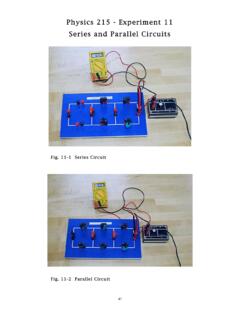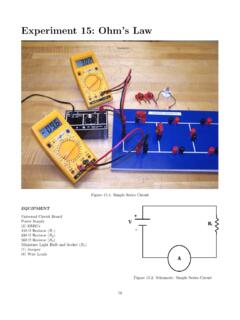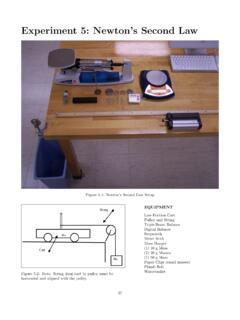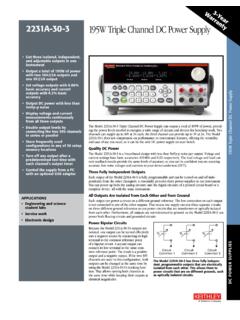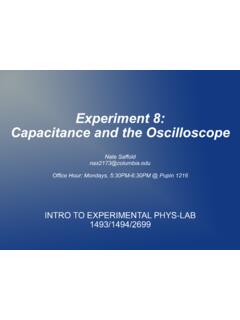Transcription of Experiment 16: Series and Parallel Circuits
1 84 Experiment 16: Series and Parallel Circuits Figure : combination circuit EQUIPMENT. Universal circuit Board (2) 100- Resistors (2) 200- Resistors (2) 300- Resistors (2) Digital Multi-Meters Power Supply (5) Jumpers (6) Wire Leads Experiment 16: Series and Parallel Circuits 85. Advance Reading resistor value. The current has more than one path available and takes all available paths. Text: Resistors in Series , Parallel , combination . For a Parallel circuit , the total equivalent resistance, Lab Manual: Req , is: Appendix C. Appendix ?? - DMM. 1 1 1 1 1 X 1 N. = + + + + = ( ). Objective Req R1 R2 R3 RN Ri i=1. The objective of this lab is to study Circuits with re- (Resistors in Parallel ).
2 Sistors connected in Series , Parallel , and combination . Theory In the previous Experiment , you constructed 4 Circuits , each circuit built with one resistive element. In this Experiment , you will construct Circuits using multiple resistors. The first type of circuit you will construct is a Series circuit (Fig. and Fig. ). In a Series circuit , the resistors are connected end-to-end such that the current is the same through each resistor: The current Figure : Parallel circuit Schematic has only one path available. The voltage drop across each resistor depends on the resistor value. The third type of circuit you will construct is a com- bination circuit (Fig. and Fig. ). Resistive For a Series circuit , the total equivalent resistance, elements are not connected in Series or Parallel .
3 To Req is: calculate the total equivalent resistance of a combina- tion circuit , it should first be simplified (reduced to an equivalent resistor, Req ). This is done by choosing re- X. N. Req = R1 + R2 + R3 + + RN = Ri ( ) sistors that are connected in either Series or Parallel , i=1 one step at a time, adding those elements by use of Eq. or Eq. , then proceeding to the next set (Resistors in Series ) of elements. Figure : Series circuit Schematic Figure : combination circuit Schematic The second type of circuit you will construct is a par- allel circuit (Fig. and Fig. ). Resistors are Note that it is not correct to, for example, calculate said to be in Parallel when they are connected to each the resistance of the 3 resistors across the top of the other at each end.
4 In this way, the potential differ- circuit using Eq. , and then calculate the resistance ence applied across the combination is the same as the of R4 , R5 , and R6 using Eq. You must identify potential difference applied across an individual resis- which resistors are either in Parallel or in Series , then tor. The current through each resistor depends on the apply the appropriate equation one step at a time. 86 Prelab 16: Series and Parallel Circuits Name: 1. What is a Series circuit ? (10 pts). 2. What is a Parallel circuit ? (10 pts). 3. Is the equivalent resistance, Req , of a Series circuit greater than or less than any individual resistor? (10 pts). 4. Is the equivalent resistance, Req , of a Parallel circuit greater than or less than any individual resistor?
5 (10 pts). 5. Calculate Req for each of the first three Circuits shown in Fig. - Fig. using the stated nominal values for resistance. (Show all work on back of this sheet.) (25 pts). 6. You will plot I vs. V for each of the three Circuits on one graph. What value should each slope have (use the stated values for resistance)? (25 pts). 7. Create Data Tables in your lab notebook for all parts of this Experiment . Sketch the column headings on the back of this sheet. (10 pts). Experiment 16: Series and Parallel Circuits 87. PROCEDURE PART 3: combination circuit PART 1: Series circuit 14. Repeat Part 1, Step 1 - Step 8, for the combination circuit (Fig. ). Record all data in table format.
6 Recall that (i = 1, 2, .. , n) PART 4: Graphing 1. Measure Ri , then construct a Series circuit 15. Graph I vs. V for each of the first three Circuits on (Fig. ) with 100- , 200- , and 300- resistors one graph (Part 1, Part 3, and Part 4). and ammeter (200 mA DCA); do not connect the power supply yet. 16. Part 5 of this Experiment may also be on an exam. 2. Draw the schematic using measured Ri 's. Be certain you know how to produce a complete graph. Ask for help if needed. 3. Calculate Req . 4. Measure Req . QUESTIONS. 5. Connect the unplugged power supply and the volt- meter (DCV) to your circuit . 1. Why should the voltage drops (electric potential dif- Get instructor approval of your circuit ferences) across the resistors connected in Parallel be the same?
7 Were your values equal? 6. Always be sure the power supply is turned off be- fore you plug it into an outlet. Plug in the power 2. Calculate the equivalent resistance of each of the supply, and set the voltage to V. Measure the first three Circuits you constructed for this experi- current and voltage. ment using your measured values. Show each step 7. Record the current (A) and the voltage (V) as you in this process (math and schematic). Remember increase the voltage in V increments up to V. to include RA in your calculations. 8. Leave the voltage at V; disconnect the voltmeter 3. Consider your data from Part 2. Create a table sim- from the power supply. Maintaining the same orien- ilar to the one shown below.
8 Why does Req change tation of the leads (if clockwise, black follows red), when you change the scale of the ammeter? measure Vi . P. 9. Add these potential differences ( i=1 Vi ). Ammeter Scale Req RA. P. 10. Does i=1 Vi equal V? If not, ask your TA for No Ammeter guidance. 20 A. 200 A. PART 2: Parallel circuit 2 mA. 11. Repeat Part 1, Step 1 - Step 8, for the Parallel cir- cuit (Fig. ). 20 mA. 12. Does V2 = V1 + VA , or does V2 = V1 = V3 ? Are 200 mA. each of these values negative or positive?! Yes, it 2A. matters! 20 A. 13. Does V = |V1 + VA |?

